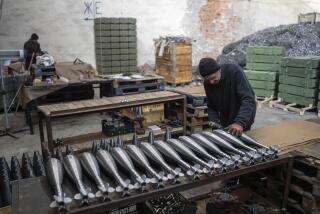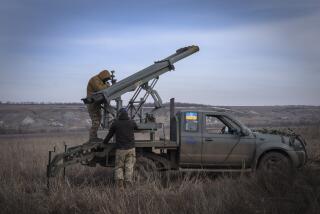War Could Overburden Defense Supply System : Procurement: Experts fear U.S. industry would be strapped to keep up with weapons and parts needs.
- Share via
The U.S. defense industry would be hard-pressed to substantially accelerate production of weapons and spare parts if a Middle East war created an urgent need to replenish existing supplies, industry executives and procurement experts say.
The United States has never deployed so many troops so quickly, providing no time for industry to mobilize. In a few months, the United States will have more than 400,000 troops in Saudi Arabia, eclipsing the peak Cold War deployment in Europe of 326,000 troops. So far, the Pentagon has supplied Middle East troops largely with equipment reserves intended for troops who would fight in Europe.
Experts are worried that the military strategy so far in Operation Desert Shield, in which a major conflict would be fought entirely with current stocks, could pose grave risks if the fighting is not resolved quickly.
Since its peak in the mid-1980s, the defense industry has undergone a substantial shrinkage, in which tens of thousands of small subcontractors have left the industry. A sudden Pentagon effort to crank up production is likely to create bottlenecks in areas that no one can predict.
The most exotic high-technology weapons are made by single companies, limiting output, and production is extremely labor-intensive. Also, a boom in commercial aircraft production has diverted resources away from defense.
“No one knows whether industry has enough capacity to respond,” said James Blackwell, an analyst at the Center for Strategic and International Studies in Washington. “In some cases, it could take up to two years to accelerate production of munitions.”
The Pentagon is now attempting to survey industry, asking for estimates of how fast weapons production could be increased and where bottlenecks might occur. Officials at Hughes Aircraft and Lockheed have reported receiving such special inquiries, but actual orders to increase production have not yet occurred.
“The Defense Department has asked us unofficially for a ‘surge assessment,’ ” said one executive. “Nobody has planned this and thought it out. As soon as this Persian Gulf problem came up, I went to my customers and said, ‘Hey fellas, you better start thinking about this.’ ”
But planning experts at the Pentagon believe supply concerns are overstated.
“We went into this Desert Shield in the wake of a huge supply buildup, so we had quite a bit of stuff on the shelf,” said Joe Muckerman, director of Emergency Planning at the Pentagon and an expert in defense mobilization. “Industry is always crying that the sky is falling. We have a huge inventory out there.”
Adding to experts’ concerns over the defense supply system was the failure of Congress in its last session to re-enact the Defense Production Act, a measure that allows the Pentagon to command the economy to put defense priorities ahead of civilian needs in a time of emergency. The Pentagon is now scrambling to determine whether it has other legal authority to take command of private firms.
But the law could be academic. Industry’s ability to “surge” weapons production may be more limited than the Defense Department realizes.
A study by Blackwell found that of the 118,489 defense firms operating in 1982, 68% or 80,482 had left the industry or gone bankrupt by 1987. Companies such as Ford, Honeywell, Goodyear Tire & Rubber, Eaton, Gould and Singer, among others, have attempted or succeeded in getting rid of defense operations.
“Nobody was smart enough to predict this big a defense effort, and this will result in a shortage of spare parts, particularly for weapons that are out of production,” said a senior executive at a prime aircraft contractor. “I am very worried that if this thing keeps going very much longer we are going to have a shortage of spare parts--even without a war.”
The experience in Saudi Arabia so far appears to bear out that prediction, according to congressional sources. The General Accounting Office has found that spare parts for Apache helicopters are so scarce that a number of the aircraft at U.S. bases have been grounded to cannibalize parts for Desert Shield operations, a House source said.
Spare parts could develop into a problem even without a war because the troops in the Persian Gulf region are using their aircraft, tanks, ships and other systems far more intensively than they normally do, wearing out parts early.
But the problem of spare parts may be easy to resolve compared to resupplying the Air Force with jet fighters or the Army with tanks, should that become necessary. Experts say it now takes about three years to build a combat jet. If all stops were pulled out and defense plants went to three production shifts, new aircraft might be rolling out of factories within one year, but no sooner.
Certain critical parts can take months to obtain, including large aircraft forgings, landing gear, optical lenses for guided missiles, certain types of specialized microprocessors, infrared sensors, signal processors and a host of other special products.
LeRoy Haugh, vice president at the Aerospace Industries Assn., said the erosion in the defense industrial base has raised concerns. “Whether it has eroded to the point where we would not be able to supply particular needs has not been tested. I haven’t heard that we would be unable to supply the needs in the gulf, but we really don’t know what those needs will be.”
Many high-tech weapons are virtually hand-built because production volume is so low. Increasing output means training more hands to build them, not running a machine for more hours per day. So-called black boxes, which contain electronic components for Hughes Aircraft radar, for example, are soldered by hand in South Carolina. The wire cables that connect the black boxes are carefully cut and laid out by hand. If Hughes wanted to step up output, it would mean increasing overtime hours or hiring additional workers.
The question haunting the defense Establishment is whether extreme measures to mobilize industry are necessary. It may seem improbable that the U.S. military, with its roughly $300-billion annual budget, could run out of weapons in a war against Iraq. But some warn that it is a mistake to run that risk.
“This fight is going to be at least as intense as the fight in Europe against the Warsaw Pact was going to be and there is the potential for a regional conflict,” said Blackwell. “The Iraqis have more tanks in Kuwait and southern Iraq than the Russians had in Germany. There is more armor and artillery in the Middle East than in Europe.”
Charles Spinney, a Defense Department analyst, believes that current planning for a short war is misguided. “Most wars are scheduled to be over quickly, and they don’t turn out that way,” he said. “The Civil War was supposed to be over in six months. In World War I, the troops left in August and were supposed to be home for Christmas.”
Spinney also argues that the military services will use far more weapons than expected in a heated battle because they have vastly overestimated the ability of costly, sophisticated weapons to hit targets. In addition, the high cost of sophisticated missiles has forced the military to scrimp on quantities. Each Navy Phoenix anti-aircraft missile, for example, costs about $1 million.
“We know from the Arab-Israeli wars that weapons usage rates just explode,” Spinney said. “We can go through our air-to-ground guided munitions pretty fast.”
Indeed, the military services have never reached their goal of having a 60-day supply of weapons and other material for their European forces. But the Pentagon’s Muckerman said the failure to have a 60-day supply is not significant because “we never reach our goals.”
The inventories of specific weapons are highly classified, but thousands of each type of missile are in storage. The Air Force, for example, bought 2,540 Maverick anti-tank missiles, and thousands of others missiles are procured annually.
Muckerman said that the Pentagon has a supply list of 4 million weapons and other items, not including the parts that go into the weapons. So, certain parts or products will always be in short supply.
“When shortages are identified, the system is there to increase production,” Muckerman said. He added that increased production has been ordered of certain unidentified products, including munitions.
RAND Corp. Vice President Michael Rich, a procurement system expert, said he is not pessimistic about the defense industry’s ability to increase production for Operation Desert Shield. But he cautions, “We don’t have a good measure of the health of the defense industrial base.”
Moreover, Rich said that while weapons inventories are enormous, the United States cannot put everything into the Middle East.
“The question is to what extent do you draw down stocks from the rest of the world before that is no longer prudent,” Rich said. “At some point, there is a stopping point where you can’t draw down any more because you will create an unsafe situation somewhere else.”
More to Read
Sign up for Essential California
The most important California stories and recommendations in your inbox every morning.
You may occasionally receive promotional content from the Los Angeles Times.











